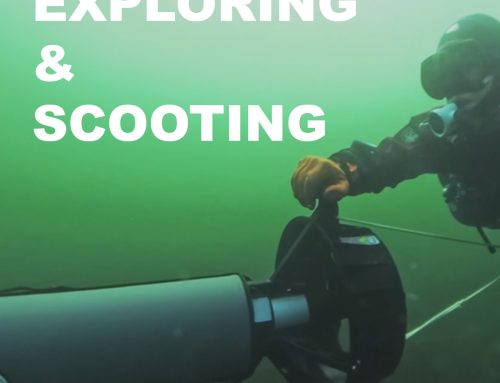Start Enjoying Your Cold Water Diving
Let’s talk about dry suit options including size, style, materials, accessories, and other customization options.
After a particularly frozen dive in my 7mm semi-dry wetsuit at Point Lobos near Monterey, I invested in an FLX Extreme trilaminate drysuit from Diving Unlimited International.
If this is your first time hearing about drysuits for scuba diving, you may want to watch my Drysuits for Beginners video. This is a great resource for people starting their drysuit journey or looking for a drysuit on a budget.
Size: Stock VS Custom
There are two types of suit sizing: stock and custom. Because drysuits are not form-fitting, stock sizing can work for many bodies, but if you want to get the most comfortable fit, custom sizing is available. When you go to a dealer, someone will take your measurements, and the suit will be made to order.
Some of the more important measurements are the length of the suit and the inseam. If your suit is too long and you have air trapped in the sock, you run the risk of your feet popping out of the foot space, losing control of your fins.
In general, you want a size that allows you to move freely with your thickest undergarments while not being so big that air gets trapped all the time.
Style: Back VS Front-Entry and Zipper Placement
I personally wouldn’t get a back-entry suit because of the fact that I consistently solo dive while on the road. If you’re always diving with a buddy, you don’t need to worry. However, a common configuration is a front-entry suit with a diagonal zipper. Learn more about solo diving here.
Zippers: Plastic VS Metal
The zipper is the most important part of the drysuit. DUI use YKK metal zippers which need to be rinsed well after each dive and generously waxed for longevity.
Based on feedback from other divers, metal zippers typically have a longer lifespan. However, I have heard from dry suit divers who have had a plastic zipper for years without any issues, so you decide!
Material: Neoprene VS Trilaminate
Trilaminate suits are super popular, and for good reason.
Their popularity is due to their versatility. The suits are made of a three-layer combo (typically a butyl rubber core with polyester or nylon on the outsides). These suits are usually more breathable than neoprene, making them desirable in places where it’s hot at the surface but cold in the water. They don’t have built-in thermal protection, so your warmth depends on your undergarments.
Neoprene is the other material option and can be great for people who don’t want to travel with their suit. Neoprene, even crushed neoprene suits, are bulkier, heavier, take longer to dry, and require more weight to descend. These suits have some thermal protection, so you can wear thinner undergarments. Also, they are relatively cheap, meaning many people end up in neoprene suits as their first step into drysuit diving.

Seals: Latex VS Silicone VS Neoprene
Neoprene is less common these days because of the level of seepage you can experience.
Latex is durable but less comfortable. Also, some people must avoid this material due to allergies.
I went with the silicone zip seals because of their heat resistance (the van gets so hot sometimes!) and the fact that I can change the seals on my own at a dive site. Since I travel a lot, I don’t want to send my suit to the manufacturer for every little issue. However, silicone is more prone to ripping, so you have to be extra careful with sand, your nails, and storage.
Boots: Built-in Boots VS Sock/Rock Boot Combo
Built-in boots are convenient, but they become a weak point in the suit. These boots are generally close in size to your wetsuit boots, so you can interchange your wetsuit and drysuit fins. They are also very comfortable and give you more control for precise finning.
My suit has built-in boots, and it’s something that I would’ve changed had I gotten a custom suit. The sock and rock boot combination is popular for those of us who do a lot of shore diving over sharp rocks or long surface walks. They tend to force you to buy a fin with a larger foot pocket, but that may not be an issue because many divers prefer to have a heavier, shorter fin when drysuit diving.
Pockets
No question here. Every diver needs pockets. For my fellow small frame divers, you can consider the small pocket option if you know you won’t need to carry a lot of gear.
Gloves: Wet VS Dry
Diving with wet gloves is doable in a lot of cool water conditions. However, dry gloves will give you the most comfort.
I have gone diving in 6C (40F) water with wet gloves, and I do not recommend it! If you’re regularly doing dives under 10C (50F), go for dry gloves.
Accessories & Customizations: P Valves & Colors
If you know you’ll need to pee during a dive, you have to decide on installing a p-valve. These can be finicky and result in accidents during your dive if not used properly. The other option is adult diapers…
I haven’t had to deal with this issue yet, but once I do, I will write a blog with details. Stay tuned…
Other ways to personalize your suit include the color of the outer material and things like patches. These are fun and helpful because divers all look the same underwater. If you choose a unique color, fabric design, or custom patch, it’s easier to distinguish who you are.
My Drysuit Journey
My original plan was to get a custom suit with the TLS350 material, kitted out with blues for Azul Unlimited, including small pockets for my petite body, and the sock/rock boot combo. Supply chain issues delayed things, so DUI found a solution with the suit I currently have. This suit was already made and waiting for someone to claim it from the factory, so it feels like I made a more sustainable choice. The fit is pretty good, and although some features are not my desired options, the suit is a well-made. The most important thing? It’s allowing me to enjoy diving I couldn’t even dream about with my wetsuit.
My DUI drysuit is now my favorite piece of scuba equipment and has changed my attitude about cold dive days. I love the comfort of diving dry, and I won’t be going back to wetsuits unless the water is actually warm.








